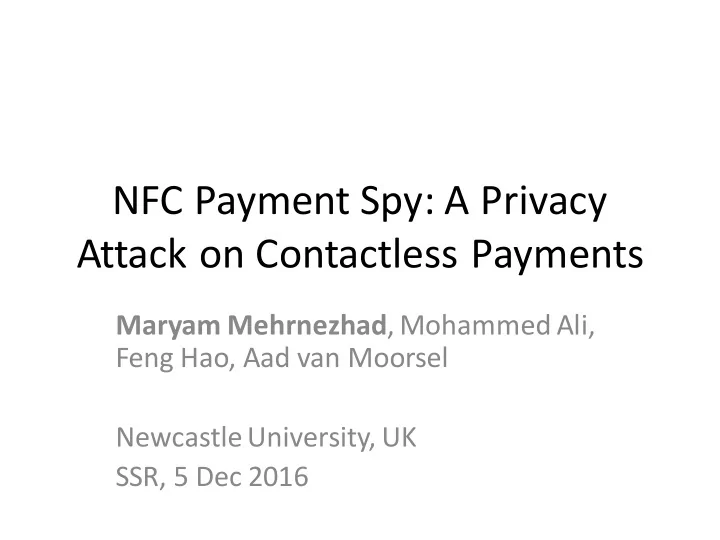

NFC Payment Spy: A Privacy Attack on Contactless Payments Maryam Mehrnezhad , Mohammed Ali, Feng Hao, Aad van Moorsel Newcastle University, UK SSR, 5 Dec 2016
Contactless Payment • Contactless Cards (theukcardsassociation.org.uk) – In the UK in Feb 2016 – £1,318.3 m contactless card payment – An increase of 306.8% per the year • Other NFC payment technologies – Mobile phones, tablets, watches, bPay bands/stickers, Visa-powered payment ring (Rio 2016 Olympics) – Over 350 different brands/models of NFC-enabled devices in the market (nfcworld.com)
What happens if there are multiple contactless cards in the reader ’ s field?
Card Clash: Oystercard and contactless bank cards • Well-publicised phenomenon (the Guardian and TfL) • While swiping a wallet on a reader paying for travel with a card did not intend • More expensive, double charged – Weekly travelcard – Touch in and out with different cards • Applying for a refund by checking online accounts – Provided by Transport for London – TfL handed back £300,000 to 50,000 customers within 3-5 working days (2014)
Suggested Solutions • Taking the card off from the wallet • Checking online accounts and claim the refund • Use protective cases for cards • Switch to contactless payment (no Oystercard) • Using other technologies (bPay band, mobile)
What do Standards Specify? • EMV: the primary standard for contactless card payments • ISO/IEC 1443: the main standard for proximity cards including payment
EMV Contactless Book D- Card Collision To ensure that there is only one PICC in the Field. The terminal will not initiate a transaction when there is more than one PICC. It will reset.
If more than a technology is in the field or collision is detected during the WUPA command Collision detected at first 4 bytes of UIDs Collision detected at first 7 bytes of UIDs Collision detected at first 10 bytes of UIDs
EMV Spec- Card Collision • Regardless of the collision procedure, once a collision is detected, the terminal should not proceed any more; instead it should reset the field and go back to the polling procedure
ISO/IEC 1443-3 standards
ISO standards- card collision • Unlike EMV, ISO specifies no termination in the case of a collision. Instead, a race condition is created in which depending on the implementation of the terminal, and the UIDs of the cards available in the field one card would be selected.
Experiments on contactless terminals • Testing multiple cards on different terminals in different metro stations
Results don ’ t match EMV/ISO
Attack based on this inconsistency • A malicious app spying on user ’ s contactless transactions
Attack Design • Simulating a card on Android HCE • Registering a Visa card AID • Requesting Processing Options Data Object List (PDOL) • A Get Processing Option (GPO) is returned • Includes the Terminal Transaction Qualifiers (TTQ), Unpredictable Number, Amount, Authorised, Transaction Currency Code, and other tags
Experiments
Phone Wins in 66% of cases
PDOL • Phone: – PDOL tag: ‘ 9F38 ’ – Amount tag: ‘ 9F02 ’ – Date tag: ‘ 9A ’ • Reader: – PDOL tag: ‘ 83 ’ – Amount: ‘ 000000000080 ’ (0.80 pence) – Date: ‘ 160523 ’ (2016 May 23)
Conclusion • Summary: – Studied card collision problem, EMV, ISO, Implementation in practice – Found inconsistency – Preformed an attack on privacy of transactions (amount, date) • More attacks: – Merchant information for Mobile payments • Solutions: – Implementation to match EMV – EMV to protect private info – Mobile platforms to rethink about the access permission of sensors
Questions!
Recommend
More recommend